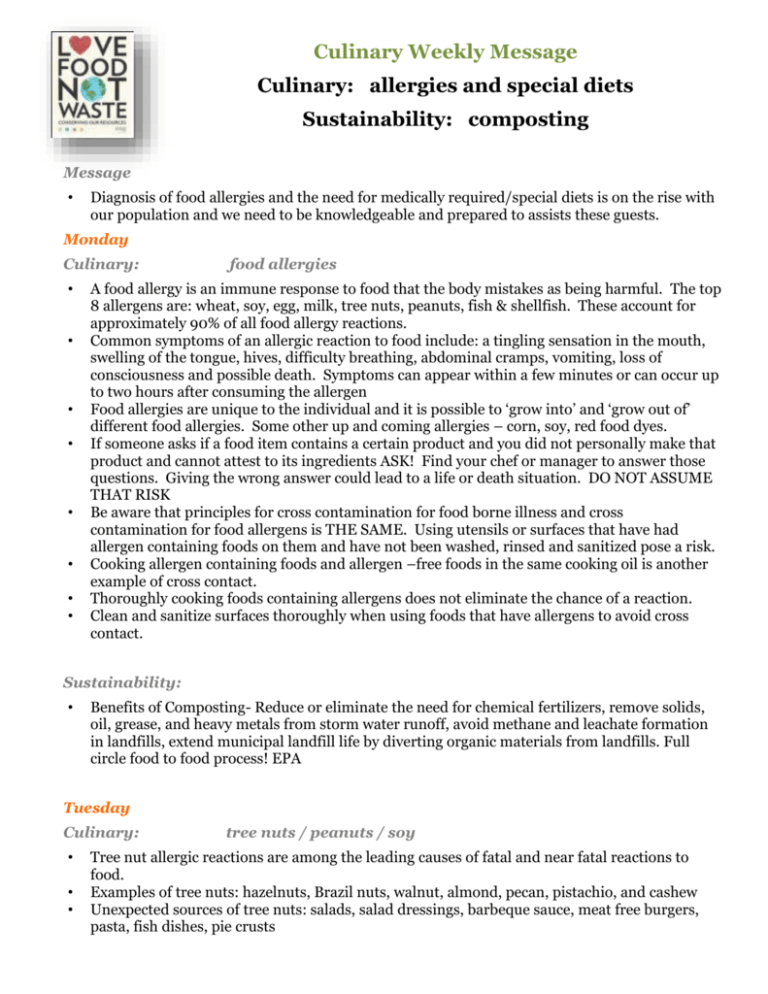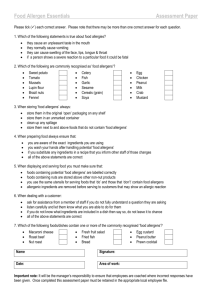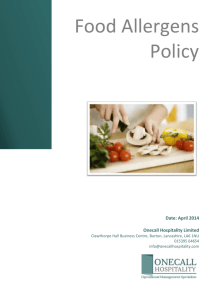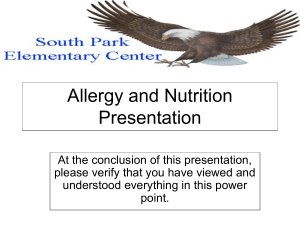allergies and special diets Sustainability: composting
advertisement

Culinary Weekly Message Culinary: allergies and special diets Sustainability: composting Message • Diagnosis of food allergies and the need for medically required/special diets is on the rise with our population and we need to be knowledgeable and prepared to assists these guests. Monday Culinary: • • • • • • • • food allergies A food allergy is an immune response to food that the body mistakes as being harmful. The top 8 allergens are: wheat, soy, egg, milk, tree nuts, peanuts, fish & shellfish. These account for approximately 90% of all food allergy reactions. Common symptoms of an allergic reaction to food include: a tingling sensation in the mouth, swelling of the tongue, hives, difficulty breathing, abdominal cramps, vomiting, loss of consciousness and possible death. Symptoms can appear within a few minutes or can occur up to two hours after consuming the allergen Food allergies are unique to the individual and it is possible to ‘grow into’ and ‘grow out of’ different food allergies. Some other up and coming allergies – corn, soy, red food dyes. If someone asks if a food item contains a certain product and you did not personally make that product and cannot attest to its ingredients ASK! Find your chef or manager to answer those questions. Giving the wrong answer could lead to a life or death situation. DO NOT ASSUME THAT RISK Be aware that principles for cross contamination for food borne illness and cross contamination for food allergens is THE SAME. Using utensils or surfaces that have had allergen containing foods on them and have not been washed, rinsed and sanitized pose a risk. Cooking allergen containing foods and allergen –free foods in the same cooking oil is another example of cross contact. Thoroughly cooking foods containing allergens does not eliminate the chance of a reaction. Clean and sanitize surfaces thoroughly when using foods that have allergens to avoid cross contact. Sustainability: • Benefits of Composting- Reduce or eliminate the need for chemical fertilizers, remove solids, oil, grease, and heavy metals from storm water runoff, avoid methane and leachate formation in landfills, extend municipal landfill life by diverting organic materials from landfills. Full circle food to food process! EPA Tuesday Culinary: • • • tree nuts / peanuts / soy Tree nut allergic reactions are among the leading causes of fatal and near fatal reactions to food. Examples of tree nuts: hazelnuts, Brazil nuts, walnut, almond, pecan, pistachio, and cashew Unexpected sources of tree nuts: salads, salad dressings, barbeque sauce, meat free burgers, pasta, fish dishes, pie crusts • • • • • Tree nuts and peanuts are two separate things, peanuts are part of the legume family Peanuts can be found in: cookies, pastries, ice cream, energy bars, cereals, grain breads, nougats and salad dressing Many cultural foods contain peanuts such as African, Chinese, Indonesian, Mexican, Thai and Vietnamese dishes Soy can be called any of the following on a product label: soy, soya, soybeans, edamame. Foods that contain soy are: natto, tamari, tempeh, miso, textured vegetable protein, shoyu (Japanese for soy sauce) Sustainability: • There are many resources needed to grow food. Including water, fertilizers, pesticides, and energy. By wasting food, you are also wasting the resources that went into growing it. Additionally, 13 percent of greenhouse gases in the United States are associated with growing, manufacturing, transporting, and disposing of food.-EPA Wednesday Culinary: • • • • wheat / Celiac Celiac disease which affects the small intestine, is caused by an abnormal immune reaction to gluten. Usually diagnosed by a gastroenterologist, it is a digestive disease that can cause serious complications, including malnutrition and intestinal damage, if left untreated. Individuals with celiac disease must avoid gluten, found in wheat, rye, barley and sometimes oats. Some obvious items that contain wheat are: breads, cakes, muffins, cereals, pastas & crackers Some no so obvious items that contain wheat are: soy sauce, beer, processed meat products such as hotdogs or cold cuts, certain brands of ice cream, jelly beans, licorice, cosmetics, food starches – not listed as corn starch, and multi-vitamin supplements. Checking labels and preventing cross contamination are the only sure ways to prevent an allergic reaction. Sustainability: • In 2010 the nationwide total bill for dumping food into landfills was more than $2 billion.EPA Thursday Culinary: • • • • • • shellfish / fish / milk / egg Shellfish allergens come from marine animals with shells which include: shrimp, crab, lobster, as well as octopus and squid Read food labels carefully. Companies are required to clearly identify even small amounts of shellfish or other allergens that cause reactions. Salmon, tuna and halibut are the most common kinds of finned fish to which people are allergic. More than half of all people who are allergic to one type of fish also are allergic to other fish, so allergists often advise their fish-allergic patients to avoid all fish Some unexpected sources of fish: Caesar dressing or Caesar salad, Worcestershire Sauce & barbeque sauce. Cow’s milk usually is the cause of allergic reactions however milk from sheep, goats, and buffalo can illicit reactions as well. Unlike other allergens rarely can a milk allergy cause anaphylaxis which is a severe life threatening reaction. • • Ingredients with egg: albumin, lysozyme, mayonnaise, meringue/meringue powder, ovalbumin & surimi Egg can be found in the following foods: egg substitutes, lecithin, marzipan, marshmallows, nougat, baked goods, salad dressings, many types of pasta. Sustainability: • Food waste disposed of in a landfill generates .69 metric tons of CO2 emissions (MTCO2E) per ton. Composting this waste offers CO2 emissions of 0.2 per ton. -EPA Friday Culinary: • • • • special diets A vegetarian is a person that does not eat meat or animal products. There are varying types of vegetarians: • Lacto vegetarians eat only plant foods as well as dairy product • Lacto – Ovo vegetarians only eat plant foods as well as dairy and eggs, which is the most common type of vegetarian. • Pescatarian - only eats plant foods as well as fish Vegans eat only plant foods. NO ANIMAL BY PRODUCTS WHICH CAN INCLUDE HONEY Guests who follow a flexitarian diet are not essentially vegetarian or vegan but they are trying to reduce the amount of animal products in the diet and work toward a more plant based diet. There are also a whole host of medical conditions that require avoidance of specific foods or an entire specific diet. If a guest comes to you with such a request please refer them to our dietitian – Daria Blachowski-Dreyer or a chef or manager. Sustainability: • There are two types of composting. Aerobic composting uses oxygen and anaerobic composting takes place in the absence of oxygen. http://whatcom.wsu.edu/ag/compost/fundamentals/biology_anaerobic.htm






